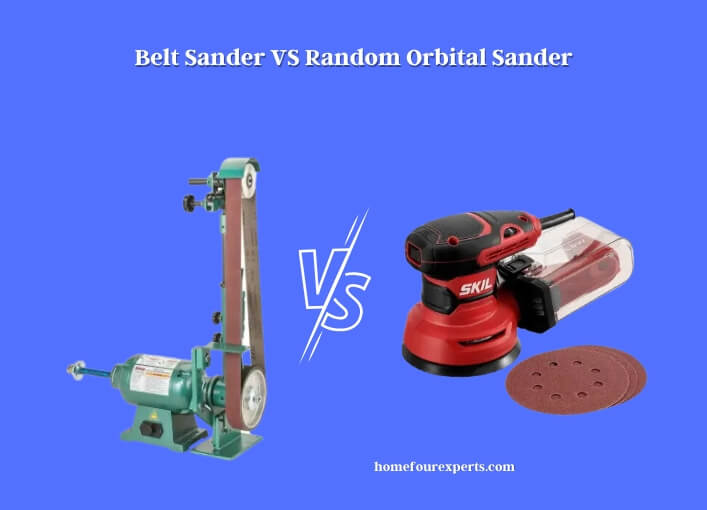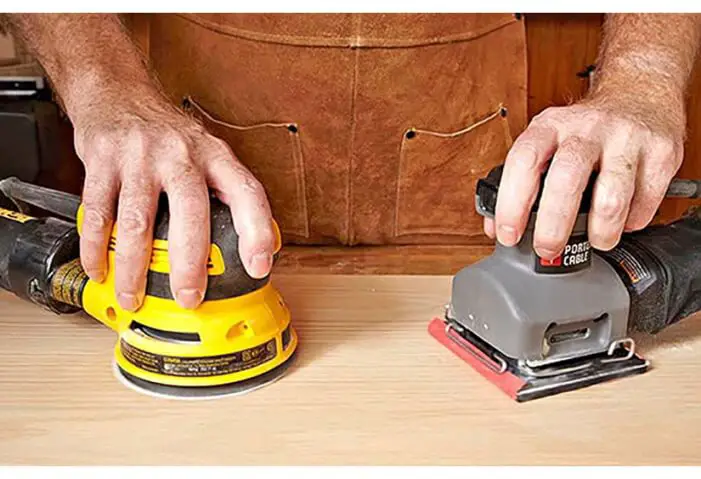Which sander is the most effective? It all depends on what you want to use it for. There are several alternatives available, and newcomers may be unsure which sander to choose. Fortunately, our belt sander vs. random orbital sander comparison provides thorough information to help you make the best decision.
Sanding is required in almost every woodworking project, whether done with a power tool or by hand. Knowing the sorts of tasks you’ll be working on can help you figure out which sander or sanders you need in your shop.

A sander is a portable power tool that is used to smooth, polish, or clean a surface, such as wood, plastic, or metal. Sanders can also be used to roughen surfaces before they are finished.Basically, there are mainly four main types of sanders that should be considered :
- Belt sander.
- Random orbital sander.
- Disc sander.
- Finishing sander.
Although there is considerable overlap in capacity and application, each of these basic categories serves a specific function. We’ll look at the distinctions between a belt sander and a random orbital sander in this article. Although there are many different types of sanders, belt and orbital sanders are the most common.
They’re both wonderful for dealing with wood floors and furniture, but they shouldn’t be used simultaneously. Because these technologies are so similar, choosing which one to use can be challenging. Simply said, if you have huge projects, you should acquire a belt sander, but if you have little or spherical works, you should get an orbital sander.
In a word, belt sanders are strong machines that can quickly strip away a piece of wood. Orbital sanders, on the other hand, are used to make wood ultra-smooth. Continue reading to discover more about belt sander and a random orbital sander.
Main Difference Between a Belt Sander and a Random Orbital Sander
The main difference between a belt sander and a random orbital sander is the type of sanding action. A belt sander uses a continuous loop of sandpaper that moves in a linear direction, while a random orbital sander uses an oscillating motion to sand the surface. The belt sander is better suited for aggressive sanding and removing material quickly, while the random orbital sander is better suited for finishing and polishing surfaces.
Is an Orbital Sander Better Than a Belt Sander?
There is no actual answer that an orbital sander is better than a belt sander. An orbital sander is more portable than a belt sander. It is also easy to operate. It also has the significant benefit of being able to utilize ordinary sandpaper, which is inexpensive and easy to buy and cut to size. It’s strong enough for most DIY sanding projects and ideal for preparing a surface for painting or varnishing.
Orbital sanders, on the other hand, are sanders that are used to make wood extremely smooth. The random orbital sander is a newer type of sander that is a good compromise between a belt sander and an orbital sander. Overall, both of these tools are required if you want to be a truly professional carpenter.
And a belt sander is ideal for swiftly and effectively completing vast surface areas. It comes in handy when you need to remove a considerable amount of wood from a thick, resistant piece of furniture.
A belt sander is the best option for doors and floors. A belt sander is more effective on a big flat surface than an orbital sander.
An orbital sander, on the other hand, is better if the surface you’re dealing with is tiny and irregular (For example a curved surface). That covers the most common scenarios, but stick around and we’ll go over all of the benefits and drawbacks of each type of sander. Belt sanders, in a nutshell, are strong machines capable of quickly stripping down a piece of wood.
Depending on the jobs you want to complete, you may require all of them: belt and random orbital sanders. There is no right or incorrect answer; it all relies on your goals for using these technologies.
What Is a Belt Sander Good for?
In a woodworking shop, belt sanders are the tough tools. Belt sanders’ design allows them to remove a large quantity of material in a short amount of time. In the hands of trained and regulated persons, however, these devices do not go amok. Belt sanders work using the concept of a continuous loop. They use a totally looped sanding belt instead of static abrasive sheets like a disc, orbital, or finishing sanders.
Sanding belts are installed within the tool housing and surround the motor’s driving wheel at the back and a free-wheeling guiding wheel at the front. While the electric motor rotates the sanding belt forward, tension settings and alignment guides maintain it in position. Read more: Can You Use a Random Orbital Sander for Car Polishing
Belt sanders are extremely successful in removing roughness and preparing woodwork for less aggressive equipment like random orbit and finishing sanders later in the process. Belt-sanding with the wood grain rather than across it is critical. Otherwise, the lateral motion of the belt sander might destroy the job. Here are some examples of when you might want to utilize a belt sander:
Belt Sanders Has a Wide Range of Applications:
- Projects with a large surface area.
- Rough surfaces to be leveled.
- Finishes are uniform and smooth.
- Jobs that will not be treated further after sanding.
Workers may snag their hands, clothes, or jewelry in the in-running rolls, which is the principal safety danger with belt sanders. Abrasions and lacerations can also result from contact with an abrasive surface.
What Type of Sanding Job is a Belt Sander Best Suited for?
A belt sander is best suited for large, flat surfaces, such as door frames, floors, and decks. It can be used for removing paint, sanding off rough spots, and leveling uneven surfaces. It can also be used for rough shaping and sanding of wood and other materials.
Can You Use an Orbital Sander in Place of a Belt Sander?
You can not use an orbital sander in place of a belt sander. Because an orbital sander is not as powerful as a belt sander, you don’t risk damaging the wood the way a belt sander would.
An orbital sander is great for sanding items that have been subjected to harsh belt sanders. They work in a back-and-forth motion to assist reduce the chance of deep markets while also removing splinters and smoothing the surface.
The abrasive pad of an orbital sander rotates in small circles, allowing you to move the sander in any direction. Belt sanders are perfect for sanding big, rough surfaces. Belt sanders, for example, are ideal for sanding hardwood floors and heavy pieces of furniture such as tables.
An orbital sander isn’t as powerful as a belt sander, but you don’t risk damaging the wood as you could with a belt sander. The orbital sander is better for tiny places and furniture, while the belt sander is better for large items.
A belt sander is best for flat surfaces, but an orbital sander may work at different angles. Belt sanders have a significant advantage over orbital sanders in terms of power. Because they are so strong, a belt sander might easily sand off too much material by accident. As a result, you should use them interchangeably.
Is a Random Orbital Sander Better?
Yes, using a random orbital sander is preferable. Random orbital sanders have a substantially higher capacity for material removal than orbital sanders. The difference is in the sandpaper sheet’s mobility. Fine sanding and finishing work may be done with orbital sanders.
They’re also great for sanding around curves, but not so much for huge pieces of wood. While they can get into tight spaces, they aren’t always superior to a random orbital sander.

Random orbital sanders, on the other hand, are the “tweener” sanders, capable of both stripping and fine sanding. Their “random” sanding process creates less obvious cross-grain scratches and no swirl pattern like an orbital sander.Because random orbital sanders aren’t as strong as belt sanders, they’ll have to work harder to remove some materials that belt sanders can easily remove.
They’re also useful for putting a finishing touch on corners without the swirls that orbital sanders produce. They’re easy to hold and only require a little pressure. In that way, it’s similar to using a good knife in the kitchen – – let the instrument do its job.
As you might assume, the dust produced by a random orbital sander is finer than that produced by a belt sander. The belt sander is used to remove material lumps, old paint, and varnish. Random orbital sanders, on the other hand, are better at finishing sanding jobs and removing less material. Read more: Orbital Sanders VS Sheet Sanders: What Are the Differences?
What Are the Advantages of Using a Belt Sander Over a Random Orbital Sander?
When comparing the uses of a belt sander versus a random orbital sander, the belt sander offers several advantages. It is great for quickly removing a large amount of material, making it perfect for smoothing rough surfaces or shaping edges. Its powerful motor and sanding belt also allow for more aggressive sanding.
Final Verdict
To wrap off this essay, we have discussed the differences between a belt sander and a random orbital sander. First and foremost, both belt and random orbital sanders are excellent equipment that you should have in your workshop. Some jobs are better suited to the former, while others are better suited to the latter.
However, if you must select one of them, there are a few things to consider. Random orbital sanders and belt sanders are two very distinct instruments. Belt sanders give brute power and require an experienced user to bring out the tool’s entire capabilities, so they’re not for beginners, but they’re essential if you’re working with huge pieces or hard materials.
Orbital sanders are on the opposite end of the spectrum. These aren’t meant to be heavy-duty tools; they’re more for fine-tuning, smoothing out uneven patches, and ironing out curves, edges, and corners.
Belt and random orbital sanders are excellent equipment to have on hand. These equipment are crucial, especially if you undertake a lot of house improvements and carpentry. If you have large projects, acquire a belt sander; if you have tiny ones, use an orbital sander. Better yet, acquire both so you can handle a variety of tasks!
Reference :
- https://en.m.wikipedia.org/wiki/Sander
- https://en.m.wikipedia.org/wiki/Belt_sander
- https://en.m.wikipedia.org/wiki/Random_orbital_sander
About This Writer

Hello, I am David Rowan. I am a professional contractor with 10 years of experience in home building, different tools used, construction, home remodeling, and other home improvement work. I have already built many custom homes and continued to do several woodworking projects along with how to deal with all categories of tools.